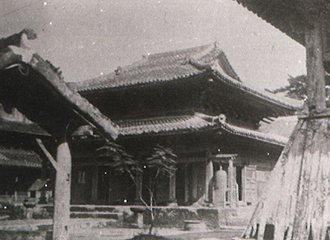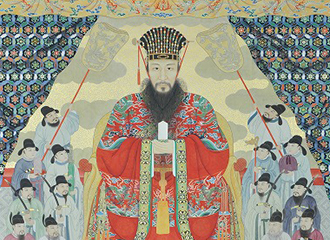MENU
Where were the Ogoe paintings?
Home > About Shurijo Castle > Ugushiku Monogatari (Story of Shurijo Castle) > Where were the Ogoe paintings?
Portraits of kings are displayed on the walls of Shuri Castle Park Nanden. Known as “Ogoe,” these are portraits of successive kings of the Ryukyu Kingdom that were painted when they passed away. Currently displayed inside Shurijo Castle Park, these Ogoe were actually not originally displayed inside the castle. They were displayed in a temple in the northern part of Shurijo Castle called Enkaku-ji. It was built in 1494 as a bodai-ji, or family temple, for the successive kings of the Second Sho Dynasty, and rituals were held there as a national event. It is believed that in the past, the Ogoe were drawn on the walls of the Enkaku-ji temple building called “Gosho-do.” According to one of the official historical records of the Ryukyu Kingdom known as “Kyuyo,” the Gosho-do was destroyed in a fire, and it is said that as a result, hanging scrolls were created starting in 1717 to replace the Ogoe that were drawn on the walls. After the Ryukyu Kingdom collapsed, copies of the Ogoe that were kept at Nakagusuku-udun (*1) were photographed by Yoshitaro Kamakura (*2), and only those black-and-white photos have conveyed the appearance of the Ogoe to the present. According to testimonies and documents written by people who directly saw the Ogoe before World War II, the Ogoe were painted in brilliant colors. Currently, there are two Ogoe pieces restored in brilliant coloring, and an Ogo-e of King Sho Iku and that of King Sho Ko were open to the public in 2014 and 2017, respectively.(Atsushi Koki)
※1 The residence of the prince during the Ryukyu Kingdom era
※2 A Japanese dyeing and weaving artist and a researcher on Okinawan culture. He inherited bingata techniques and was designated a holder (a Ningen Kokuho, or a Living National Treasure) of “Katae-zome,” an important intangible cultural property. Materials such as the large number of photographs he shot and memos he wrote down when he investigated cultural assets in Okinawa before World War II have contributed to the preservation and reconstruction of Okinawan culture that was on the verge of devastation during the last war.
-

Enkaku-ji Temple(possession of Naha City Museum of History) -

Ogoe of King Sho Ko
© Shurijo Castle Park All Rights Reserved.